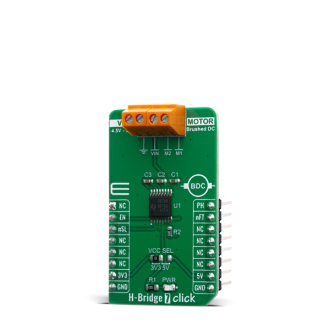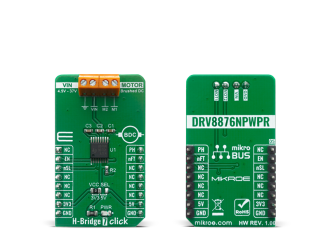
We strongly encourage users to use Package manager for sharing their code on Libstock website, because it boosts your efficiency and leaves the end user with no room for error. [more info]

Rating:
Author: MIKROE
Last Updated: 2020-06-23
Package Version: 1.0.0.0
mikroSDK Library: 1.0.0.0
Category: Brushed
Downloaded: 3164 times
Not followed.
License: MIT license
H-Bridge 7 Click features flexible motor driver IC for a wide variety of applications, labeled as the DRV8876N. This Click board integrates an N-channel H-bridge, charge pump regulator, and protection circuitry. The charge pump improves efficiency by allowing for both high-side and low-side N-channels MOSFETs and 100% duty cycle support.
Do you want to subscribe in order to receive notifications regarding "H-Bridge 7 click" changes.
Do you want to unsubscribe in order to stop receiving notifications regarding "H-Bridge 7 click" changes.
Do you want to report abuse regarding "H-Bridge 7 click".


Library Description
The library contains basic functions for working with the H-Bridge 7 click.
Key functions:
void hbridge7_motor_state ( uint8_t state ) - Set motor statevoid hbridge7_motor_control ( uint8_t ctrl ) - Set motor controluint8_t hbridge7_get_fault_state ( void ) - Get Fault pin stateExamples description
The application is composed of three sections :
void application_task ( )
{
hbridge7_motor_control( HBRIDGE7_MOTOR_FORWARD );
Delay_ms( 3000 );
hbridge7_motor_control( HBRIDGE7_MOTOR_BACKWARD );
Delay_ms( 3000 );
hbridge7_motor_control( HBRIDGE7_MOTOR_STOP );
Delay_ms( 3000 );
}
Other mikroE Libraries used in the example:
Additional notes and informations
Depending on the development board you are using, you may need USB UART click, USB UART 2 click or RS232 click to connect to your PC, for development systems with no UART to USB interface available on the board. The terminal available in all MikroElektronika compilers, or any other terminal application of your choice, can be used to read the message.